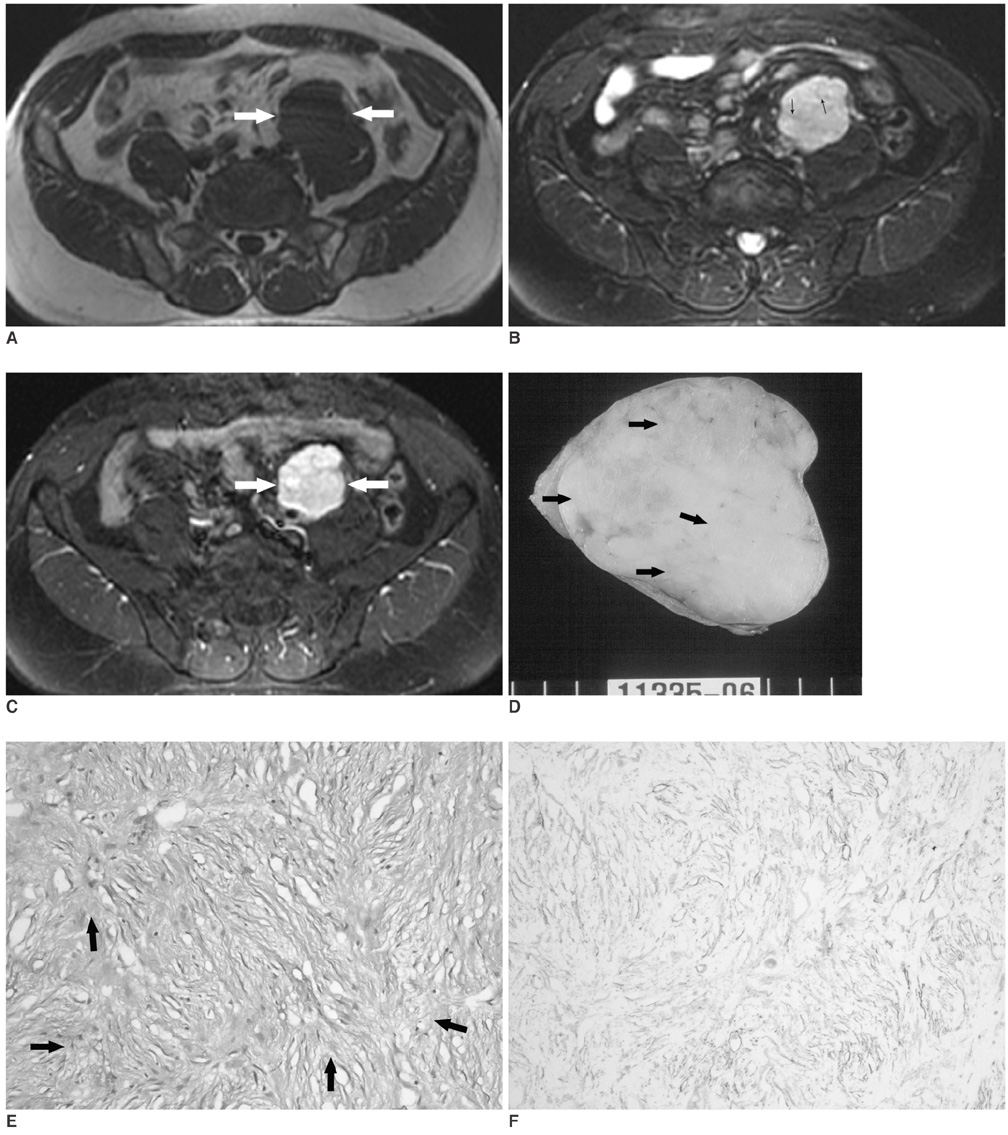Korean J Radiol.
2008 Jun;9(3):279-282. 10.3348/kjr.2008.9.3.279.
Myxoid Solitary Fibrous Tumor of the Retroperitoneum: MRI Findings with the Pathologic Correlation
- Affiliations
-
- 1Department of Radiology, Chonnam National University Hospital, Gwangju, Korea. kjradsss@dreamwiz.com
- 2Department of Radiology, Chonnam National University Hwasun Hospital, Chonnam, Korea.
- KMID: 1758463
- DOI: http://doi.org/10.3348/kjr.2008.9.3.279
Abstract
- We report here on a case of solitary fibrous tumor of the retroperitoneum, and the tumor displayed a predominantly myxoid histology. A 56-year-old man presented with an incidentally detected retroperitoneal mass. On the MR images, the mass was observed as having iso-signal intensity on the T1-weighted images and high signal intensity on the fat-saturated T2-weighted images. The mass showed intense enhancement on the Gd-DTPA enhanced T1-weighted images. At surgery, a well-defined solid mass was found in the left retroperitoneum. The histological diagnosis was made as solitary fibrous tumor with a predominantly myxoid histology.
MeSH Terms
Figure
Reference
-
1. Gengler C, Guillou L. Solitary fibrous tumor and haemangiopericytoma: evolution of a concept. Histopathology. 2006. 48:63–74.2. Vossough A, Torigian DA, Zhang PJ, Siegelman ES, Banner MP. Extrathoracic solitary fibrous tumor of the pelvic peritoneum with central malignant degeneration on CT and MRI. J Magn Reson Imaging. 2005. 22:684–686.3. Johnson TR, Pedrosa I, Goldsmith J, Dewolf WC, Rofsky NM. Magnetic resonance imaging findings in solitary fibrous tumor of the kidney. J Comput Assist Tomogr. 2005. 29:481–483.4. de Saint Aubain Somerhausen N, Rubin BP, Fletcher CD. Myxoid solitary fibrous tumor: a study of seven cases with emphasis on differential diagnosis. Mod Pathol. 1999. 12:463–471.5. Wei YC, Li CF, Sung MT, Chen YT, Ko SF, Eng HL, et al. Primary myxoid solitary fibrous tumor involving the seminal vesicle. Pathol Int. 2006. 56:642–644.6. Goodlad JR, Fletcher CD. Solitary fibrous tumor arising at unusual sites: analysis of a series. Histopathology. 1991. 19:515–522.7. Kim HJ, Lee HK, Seo JJ, Kim HJ, Shin JH, Jeong AK, et al. MR imaging of solitary fibrous tumors in the head and neck. Korean J Radiol. 2005. 6:136–142.8. Chun HJ, Byun JY, Jung SE, Kim KH, Shinn KS. Benign solitary fibrous tumor of the pre-sacral space: MRI findings. Br J Radiol. 1998. 71:677–679.9. Nagase T, Adachi I, Yamada T, Murakami N, Morita K, Yoshino Y, et al. Solitary fibrous tumor in the pelvic cavity with hypoglycemia: report of a case. Surg Today. 2005. 35:181–184.10. Gold JS, Antonescu CR, Hajdu C, Ferrone CR, Hussain M, Lewis JJ, et al. Clinicopathologic correlates of solitary fibrous tumors. Cancer. 2002. 94:1057–1068.
- Full Text Links
- Actions
-
Cited
- CITED
-
- Close
- Share
- Similar articles
-
- Solitary Fibrous Tumor in Retroperitoneum
- Myxoid Solitary Fibrous Tumor on the Scalp
- Malignant Solitary Fibrous Tumor of Retroperitoneum Mimicking Gastric Submucosal Tumor
- Intramedullary Solitary Fibrous Tumor of Cervicothoracic Spinal Cord
- Dedifferentiated Liposarcoma of the Retroperitoneum: A case report


